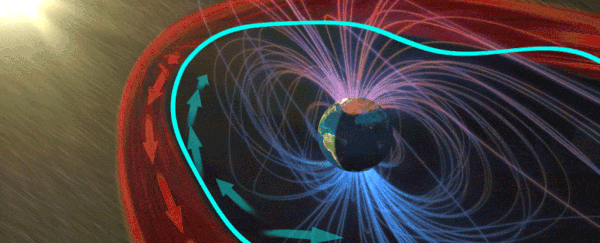Buffeted by a constant stream of charged particles from the solar wind, Earth is not without its protection. Our planet is wrapped in a bubble of magnetism called the magnetosphere, spun out from deep inside the planet's interior.
As the solar wind blows, scientists assumed that the edges of this bubble would ripple in a series of energy waves in the plasma, generated by the interaction between the solar wind and magnetosphere, along the direction that the wind is blowing. But now they've discovered a surprise: some of the waves generated stand still.
Space physicist Martin Archer of Imperial College London has been exploring the boundary of Earth's magnetosphere for several years.
"Understanding the boundaries of any system is a key problem," he says. "That's how stuff gets in: energy, momentum, matter."
Recently, Archer and his colleagues discovered that the boundary of the magnetosphere, called the magnetopause, behaves like the membrane of a drum: Strike it with a pulse from the solar wind, and waves, called magnetosonic waves, propagate along the magnetopause towards the poles, and are reflected back towards the source.
Now, using data from NASA's Time History of Events and Macroscale Interactions during Substorms (THEMIS) mission, a team of researchers led by Archer have discovered that, not only do these magnetosonic waves bounce back, they can do so traveling against the direction of the solar wind.
So what happens when these waves encounter the opposing wind? According to modelling conducted by the researchers, the two forces can reach an impasse, with the push of the solar wind cancelling out the push of the wave. A lot of energy is being applied, but nothing is going anywhere.
"It's similar to what happens if you try walking up a downwards escalator," Archer says. "It's going to look like you're not moving at all, even though you're putting in loads of effort."
Because these standing waves hang around longer in Earth's magnetosphere, they could have a more significant effect on particle acceleration, which in turn affects Earth. We know that plasma waves have an accelerating effect on electrons, which can "surf" the plasma waves like a wakesurfer uses water waves to accelerate.
Particles that accelerate along the magnetic field towards the poles are responsible for the gorgeous aurora that light up our skies (as well as communications problems in the ionosphere).
Earth's radiation belts, confined by the magnetosphere, could also be affected. More research will be required to understand what effects these standing waves have on particle acceleration.
Meanwhile, the researchers also translated the standing waves into sound. Archer and his colleagues have done this before, translating the sound of the magnetopause's drum-like responses to the solar wind.
It's not just a fascinating thing to experience; translating space data into a different medium can help scientists reveal information that might have otherwise passed us by.
"While in a simulation we can see what's going on everywhere, satellites can only measure these waves where they are giving us only time-series, wiggly lines. This sort of data is actually best suited to our sense of hearing than sight, so listening to the data can often give us a more intuitive idea of what's going on," Archer explains.
"You can hear the deep breathing sound of the standing surface waves persist throughout, rising in volume as each pulse hits. Higher pitched sounds, associated with other types of waves, don't last nearly as long."
The research has been published in Nature Communications.
